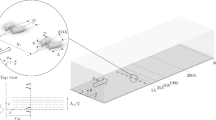Abstract
A new Eulerian (field) Monte Carlo method for solving an equation that describes the one-time one-point probability density of species mass fractions in turbulent reactive gas flows has been proposed in a previous article. In the present paper, this method is extended to an equation for the joint velocity and mass-fraction probability density function. The method is based on passing from Lagrangian variables used in Lagrangian Monte Carlo methods to Eulerian variables. In this manner, stochastic ordinary differential equations for the Lagrangian trajectories of fluid particles are transformed to partial stochastic equations. As compared to the classical hydrodynamics, the stochastic velocity field satisfies only the mean continuity constraint and not the instantaneous one. As a consequence, one has to introduce a stochastic density, which differs from the physical density but has the same mean value. The case of the mass-fraction probability density is revised. The equations differ from those derived previously: they can be written in divergent form. Both formulations, however, are statistically equivalent.
Similar content being viewed by others
References
S. B. Pope, “PDF methods for turbulent reactive flows,” Prog. Energ. Combust. Sci., 27, 119–192 (1985).
L. Valiño, “A field Monte Carlo formulation for calculating the probability density function of a single scalar in a turbulent flow,” Flow, Turbulence Combust., 60, 157–172 (1998).
V. A. Sabel’nikov and O. Soulard, “Rapidly decorrelating velocity field model as a tool for solving Fokker-Planck PDF equations of turbulent reactive scalars,” Phys. Rev., E, 72, 016301 (2005).
V. R. Kuznetsov and V. A. Sabel’nikov, Turbulence and Combustion, Hemisphere, London (1990).
V. I. Klyatskin, Stochastic Equations through the Eye of a Physicist, Elsevier (2005).
S. B. Pope, Turbulent Flows, Cambridge Univ. Press (2000).
C. Gardiner, Handbook of Stochastic Methods, Springer (1985).
J. Villermaux and J. Devillon, “Représentation de la redistribution des domaines de ségrégation dans un fluide par un modéle d’interaction phénoménologique,” in: 2nd Int. Symp. Chem. React. Eng., Vol. B-1-13, Amsterdam (1972).
P. Magre and G. Collin, “Application de la drasc á l’opération A3C,” Techn. Report R.T.S. ONERA 7/3608 EY, ONERA/DEFA (1994).
V. A. Sabel’nikov and O. Soulard, “White in time scalar advection model as a tool for solving joint composition PDF equations: Derivation and application,” Flow, Turbulence, Combust., 77, Nos. 1–4, 333–357 (2006).
C. K. Westbrook and F. L. Dryer, “Chemical kinetics modeling of hydrocarbon combustion,” Prog. Energ. Combust. Sci., 10, No. 1, 1–57 (1984).
Author information
Authors and Affiliations
Additional information
__________
Translated from Fizika Goreniya i Vzryva, Vol. 42, No. 6, pp. 144–155, November–December, 2006.
Rights and permissions
About this article
Cite this article
Soulard, O., Sabel’nikov, V.A. Eulerian Monte Carlo method for the joint velocity and mass-fraction probability density function in turbulent reactive gas flows. Combust Explos Shock Waves 42, 753–762 (2006). https://doi.org/10.1007/s10573-006-0111-x
Received:
Issue Date:
DOI: https://doi.org/10.1007/s10573-006-0111-x




